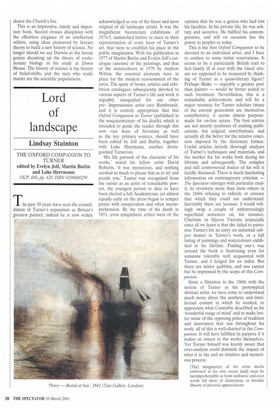Lord of landscape
Lindsay Stainton
THE OXFORD COMPANION TO TURNER edited by Evelyn Jo11, Martin Butlin and Luke Herrmann OUP, i60, pp. 420, ISBN 0198600259 The past 30 years have seen the consolidation of Turner's reputation as Britain's greatest painter; indeed he is now widely acknowledged as one of the finest and most original of all landscape artists. It was the magnificent bicentenary exhibitions of 1974-5, unmatched before or since in their representation of every facet of Turner's art, that were to establish his place in the public imagination. With the publication in 1977 of Martin Butlin and Evelyn Joll's catalogue raisonne of the paintings, and that of the watercolours in 1979 by Andrew Wilton, the essential elements were in place for the modern reassessment of the artist. The spate of books, articles and exhibition catalogues subsequently devoted to various aspects of Turner's life and work is arguably unequalled for any other preImpressionist artist save Rembrandt, and it is entirely appropriate that this Oxford Companion to Turner (published in the sesquicentenary of his death), which is intended to guide the reader through this now vast mass of literature as well as the key primary sources, should have been edited by Joll and Butlin, together with Luke Herrmann. another distinguished Turnerian.
'His life partook of the character of his works,' noted his fellow artist David Roberts, It was mysterious, and nothing seemed so much to please him as to try and puzzle you.' Turner was recognised from the outset as an artist of remarkable powers, the youngest person to date to have been elected a full Academician, yet almost equally early on the press began to temper praise with exasperation and often incomprehension. By the time of his death in 1851, even sympathetic critics were of the opinion that he was a genius who had lost his faculties. In his private life, he was solitary and secretive. He baffled his contemporaries, and still on occasion has the power to perplex us today.
This is the first Oxford Companion to be devoted to an individual artist, and I have to confess to some initial reservations. It seems to be a particularly British trait to feel faintly ill at ease with the visual arts: are we supposed to be reassured by thinking of Turner as a quasi-literary figure? Perhaps Blake — arguably a greater poet than painter — would be better suited to such treatment. Nevertheless, this is a remarkable achievement, and will be a major resource for Turner scholars (many of the current generation are themselves contributors); it seems almost purposemade for on-line access. The best entries are not merely syntheses of existing publications, but original contributions, and actually all the better for the relative concision imposed by the dictionary format. Useful articles include thorough analyses of Turner's techniques and materials, and the market for his works both during his lifetime and subsequently. The complex and still controversial matter of his will is lucidly discussed. There is much fascinating information on contemporary criticism — The Spectator emerges with particular credit, its reviewers more than most others in the 1840s refusing to ridicule or censure that which they could not understand. Inevitably there are lacunae: I would willingly swap a couple of embarrassingly superficial sentences on, for instance, Chartism or Queen Victoria (especially since all we learn is that she failed to patronise Turner) for an entry on industrial subject matter in Turner's work, or a full listing of paintings and watercolours exhibited in his lifetime. Finding one's way around the book is frustrating even for someone tolerably well acquainted with Turner, and I longed for an index. But these are minor quibbles, and one cannot but be impressed by the scope of this Companion.
Since a flirtation in the 1960s with the notion of Turner as the prototypical abstract artist, we have come to understand much more about the aesthetic and intellectual context in which he worked, to appreciate what Constable described as his 'wonderful range of mind' and to make better sense of the opposing poles of tradition and innovation that run throughout his work: all of this is well-charted in the Companion. It will have fulfilled its purpose if it makes us return to the works themselves. Yet Turner himself was keenly aware that over-analysis could diminish the impact of what is in the end an intuitive and mysterious process:
[The] imagination of the artist dwells enthroned in his own recess [and] must be incomprehensible as from darkness; and even words fall short of illustration, or become illusory of pictorial appreciations.


































































 Previous page
Previous page